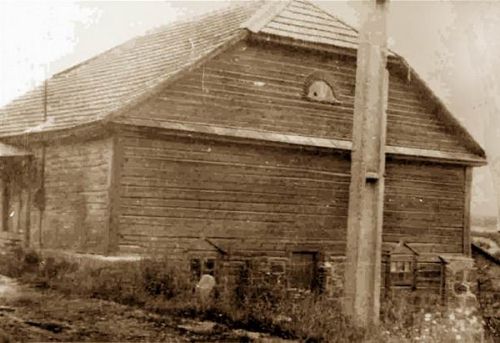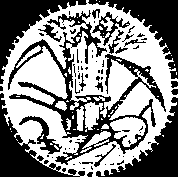
|
“That place was beautiful and pastoral…”
|
On Joining “Hechalutz”[3]
In 1919, Sheine Shapira (mother of Chemda Yanai from Kfar Massarik) came to Dusiat. She invited me to come to her village, Kalinishok, and teach her children Hebrew. They had a hydraulic flourmill, and that place was beautiful and pastoral. The mill was a meeting point for different people.
|
|
| Family Shapira's Hydraulic Flourmill, Kalinishok
“That place was beautiful and pastoral…” |
I taught the children the Hebrew language and Hebrew songs, and liked it there. About a month after my arrival, I met my cousin Chava Adelman (married to Shimon Pores) who stopped in Kalinishok on her way from Dusiat to visit her father Chaim-Leib's family in Taragin. Chava tried to influence me to move to Utian (Utena), a nearby town, and teach there. “Utian is a great town! They would love to have a teacher like you.” When I told Sheine about it, she was mad: “And where would we get another teacher for our children? We have you! If your mother had known about this, she would be very angry!” She also said that she was afraid Chava was up to something… In spite of this incident, Sheine gave me “Hanukah gelt” (money), and I realized I had treated her unfairly.
I should mention that before I went to Kalinishok, we had a class in our shtetl to spread the Hebrew language. Meir Levitt and Aharon Poritz were also among the active teachers there. Batya Levitt studied there too.
|
|
May 19, 1920, 1850 years of exile [since the destruction of the Second Temple] From right to left, top: Yosef-Yoske Kagan son of Asher, Dov-Berke Levitt son of Hirshl, Yosef Slep (holding the placard “Hechalutz”) Seated: Aharon Poritz, Lesl-Laska Zilber, sisters Chava and Etka Chatzkel (from Utian), Pessia daughter of Asher Kagan, Chana-Grunka Gordon, Chaya-Tema daughter of Zalmen Kagan |
And then the activities of the Zionist movement began. There was a “club” in Utian that I would either walk or ride to. I would also visit my relatives Hershel Chatzkel (today Shekel), Yona Berman and Yoske Kagan. In the assembly hall, we heard some lectures and speeches. They also gave us some literature about Hechalutz. I joined the movement, and made new friends.
One day, there was a convention in Kovno, held by the Zionist Federation. My friends came to visit me in Kalinishok and suggested I go to Kovno as a delegate. I went to the offices of the Zionist Federation in Utian, to receive a delegate's card, but was told: “We don't have anything against you personally, but since there is a trend in Hechalutz that demands they separate themselves from the Zionist Federation, we can't give you a card…”
At that time, I applied to Hechalutz headquarters to go on hachshara[4]. I left my teaching position in Kalinishok, and went home. I didn't want to commit to any other job in shtetl, so I accepted my mother's offer to teach Hebrew to my sisters and my brother Micha, as well as my relative Rasya Kagan (today Tal), and one of the Shub children. I taught them in our house, and their parents paid me. I stayed in Dusiat, waiting for an invitation from Hechalutz. Meanwhile, my neighbor and friend, Chaim Levitt, had already received an invitation, and so did the others: Finkel and Zingol from Utian, Shlomo Kopelevitch (Ben-David) from Ushpol (Uzpaliai), and David Shur from Plungian (Plunge) - and I was still waiting. It took two months before I received my invitation. I arrived at Hechalutz headquarters in Kovno, and apologized for not being able to speak the Sephardic version of Hebrew. I still can hear the answer: “Don't worry about it. Daber (Speak)!” The next day, I was referred to the Talaishok farm.
At home, right before I left, Mom noticed I wasn't wearing the “Arba Kanfoth”. My little brother Micha said: “Take mine,” and took his off, handed it to me, and said: “Goodbye, Yosef. Have a safe trip.” And Mother started to weep. It moves me even now, thinking about it.
I remember that coat (“Arba Kanfoth”) making my friends laugh. Why? I had a hard time finding my way to the farm, so I walked into one of the houses to ask for directions. I found three girls there, and asked: “Vu geitmen (How do I get there)?” They didn't answer, but rather burst out laughing, pointing in the direction. I didn't understand why they were laughing until I arrived at the farm and the guys there told me that they had spent the night before with those girls, if I knew what that meant… The moment the guys noticed my “Arba Kanfoth”, they burst out laughing too, and said: “Well, a guy like that, what does he know…”
Hachshara in Talaishok and Yanova
 |
In the beginning, hachshara was seasonal – one or two summers working in farms and estates mainly leased by Jews, across Lithuania. In the 1920's, the farm training was mainly in the region of Klaipeda (Memel) where some of the estates were owned by Germans.[5] |
I was sent to agricultural training in the Talaishok farm, near Kalvaria (in the Suvalk Region). My friend Chaim Levitt from Dusiat was with me.
The tenant of the farm was a Jew, and the workers were Lithuanians. We would receive pocket money and groceries. Later on a few girls joined us, and they would make our meals.
We would work the fields, and walk around barefoot. One time I stepped on a thorn, and my foot became infected, so I was sent to work in the kitchen until it healed. At that time, there were only us guys. I remember I was cooking potatoes, and the water started overflowing. “What are you doing standing there? Close the door!” the Jewish maid yelled at me. Innocent boy that I was, I hurried to shut the door, thinking that the wind was causing the water to boil over. The girl started laughing. Only then did I realize that she jokingly suggested that I close the door to prevent the water from flowing outside…
The medical attention I received did not help, and I continued working in the kitchen. One morning a girl showed up at the door, and said she had been sent there. “How's the foot?” she checked. She turned out to be a nurse called Bat-Sheva Yashpan from Ponevezh. The guys ruled: while the foot is still infected, teach the girl some Hebrew! And so I did. She would take care of my foot, and I would teach her Hebrew.
We worked there all summer, and then we were sent to the Yanova estate, which was also leased by a Jew. I remember we did not fast on Yom Kippur, and that particular Jew chose to excommunicate us Epicureans, and maintained contact only with one person who came from a highly orthodox shtetl, and did not have the nerve not to fast…
In Yanova we also worked the fields. They grew tobacco there, and we would bring tobacco leaves to our friends in Ungina – the training farm near ours.
On one occasion, one of the boys arose at dawn and climbed up on the roof to take tobacco leaves, but was caught red-handed by the landlady. She was only half-dressed, and he yelled at her in Yiddish: “Baleboste (landlady), you're going to make me blind!” She yelled back: “Wouldn't hurt you!” and disappeared.
A while later, we had the “characteristica”[6] in our group, as was customary in those days, and Bat-Sheva was one of the people being tested. “What made you join Hechalutz?” She replied candidly, that it was a broken heart, “and if I get disappointed again, I'll be done with my life.” This “confession” did it. She was refused approval to make aliya. Since it was not Zionism that drove her to join Hechalutz, she was found unfit. I was a member of the committee then, and to this day I cannot forgive myself for that silly injustice. A while later, I met her in Kovno with a companion. She introduced him as a “friend”, and said he was not a Zionist. And whenever I would meet her sister Sonya Yashpan in Israel, I would inquire after her.
|
|
From right to left, top: Bat Sheva Yashpan and Kadishai Standing: Chaim Levitt [Dusiat], Shlomo Kopelewitz [Ushpol], David Shur [Plungian], a religious man whose name I've forgotten, Haviva Dagan [Kovno], Moshe Finkel [Utian], Yechiel [Suvalk] Seated: Dov Zingol [Utian], Yosef Slep [Dusiat] Behind the carriage (left): A Lithuania farmer looking on |
Sara Weiss (Slep): On the sixty-fifth anniversary of Yosef's aliya to Eretz Yisrael I invited Shlomo Kopelewitz to meet his friend, Yosef. “Do you know this man?” – I asked my uncle. Yosef looked at the man and answered: “Shlomo!” “When did you last meet him?” – I continued. “Sixty-five years ago, when we made aliya together…”
Much later, I found out why I was called to join the training program: In Hechalutz headquarters, there was Eliezer Pearlson[7] (Perry), who could barely speak Hebrew. He encouraged his friends to look for an “influential guy” to join them, and since most of them knew me, and my knowledge of Hebrew must have made an impression, they decided to ask me to join. If it hadn't been for Pearlson's suggestion, who knows where I would be today…
Footnotes
|
JewishGen, Inc. makes no representations regarding the accuracy of
the translation. The reader may wish to refer to the original material
for verification.
JewishGen is not responsible for inaccuracies or omissions in the original work and cannot rewrite or edit the text to correct inaccuracies and/or omissions.
Our mission is to produce a translation of the original work and we cannot verify the accuracy of statements or alter facts cited.
 Dusetos, Lithuania
Dusetos, Lithuania
 Yizkor Book Project
Yizkor Book Project
 JewishGen Home Page
JewishGen Home Page
Copyright © 1999-2026 by JewishGen, Inc.
Updated 2 May 2025 by LA